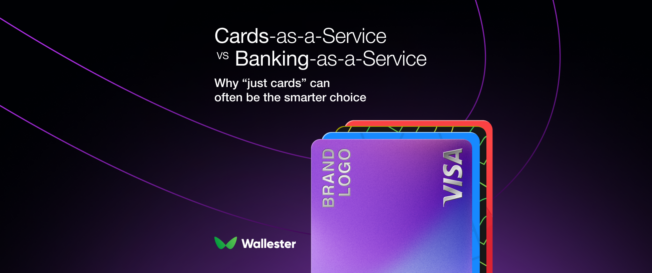In 2024, Europeans processed 72.1 billion cashless transactions, but most of them didn’t happen through traditional banks. From food delivery apps offering instant loans to coworking spaces issuing corporate cards, companies across industries are realising that customers aren’t looking for a new bank account; they want financial capabilities embedded in the experiences they already love.
But here’s the twist: most of them have been asking the wrong question. It’s not How do we become a bank? It’s Do we really need full banking infrastructure… or just cards that work?
What Is Cards-as-a-Service (CaaS)?
Cards-as-a-Service is a platform that allows any company to issue and manage payment cards without building a bank from scratch. It’s like having a card factory ready to go: you connect your app, set the rules, and start issuing cards in minutes.
The technical stack typically includes five essential components:
- Card issuing: Instantly create virtual and physical cards with secure, unique credentials.
- Transaction processing: Real-time authorisation and settlement via networks like Visa or Mastercard.
- Spend controls: Customisable limits by card, merchant, category, or time window.
- Reporting and analytics: Real-time dashboards, transaction histories, and data exports.
- API integration: Programmatic control of the entire card lifecycle through developer-friendly APIs.
This model is especially useful for companies that want to integrate payment functionality without dealing with banking licences or complex internal builds. Common use cases include:
- Commercial or consumer lending platforms distributing funds quickly and traceably.
- Marketplaces and e-commerce platforms paying out sellers via branded cards.
- Employers or gig platforms compensating workers and freelancers.
- Fintechs and digital asset companies embedding payments into core products.
- Insurers streamlining claims disbursement with prepaid cards.
- Loyalty, membership and reward programmes offering exclusive benefit cards.
- Subscription and streaming platforms improving retention through cashback or top-up cards.
In each case, these financial tools simplify payments while becoming a natural extension of the brand and user experience.
CaaS vs BaaS: What’s the Difference?
Though they share the “as-a-Service” suffix, Cards-as-a-Service (CaaS) and Banking-as-a-Service (BaaS) are not the same, nor are they designed to solve the same problems. Knowing the difference is essential to avoid over-engineering (or underestimating) what your business needs.
BaaS is ideal for building full-scale digital banks. CaaS is for businesses seeking speed, control and flexibility without the overhead of an entire banking infrastructure.
The reality? For 80% of practical use cases, CaaS is more than enough. It enables companies to deliver robust financial experiences without the burden of building a bank.
| Feature | CaaS | BaaS |
| Infrastructure scope | Card issuing and management only | Full banking infrastructure |
| Regulatory complexity | Low | High (licensing, ongoing compliance) |
| Use case focus | Spending, control, agile payouts | Complete financial ecosystem |
| Cost and compliance | Lean, low operational burden | Higher investment and regulatory barriers |
| Example use case | Rewards, corporate cards | Neobanks, full-stack fintechs |
Why “Just Cards” Is Often the Smartest Move
For companies that want to move fast, test ideas, or simply don’t need full banking capabilities, focusing on card infrastructure can mean the difference between agile growth and regulatory drag.
Choosing a card-centric model reduces implementation time, offers complete control over the user experience, and avoids unnecessary compliance overhead, all without compromising functionality or scalability.
- Speed to market: Launch in weeks, not months. Rapid go-to-market enables faster validation and user adoption.
- Greater UX control: Own the product experience without navigating banking-level compliance. Iterate freely and focus on your core value.
- Lower upfront costs: No banking licence required. The CaaS provider handles compliance and bank relationships.
What to Look for in a Cards-as-a-Service Partner
Not all card providers are created equal. Choosing the right partner can be the difference between a functional solution and a brand-defining experience.
Full Brand Flexibility
- White-label everything: Your branding should be present from the card design to the mobile app. Customers shouldn’t even know there’s a provider behind it.
- Limitless visual customisation: Colours, logos, typography, and even UI elements should feel native to your ecosystem.
Advanced Technical Capabilities
- Real instant issuing: Virtual cards should be live in seconds. Physical card delivery should be trackable and globally efficient.
- Well-documented APIs: Real documentation, code samples, interactive sandboxes, SDKs. Your developers deserve better than guesswork.
- Diverse card types: Native support for virtual, prepaid, debit, credit, and white-label cards without complex configurations.
European Regulatory Compliance
- Automatic compliance: PSD2, KYC/AML, tokenisation, 3D Secure and fraud prevention should be seamlessly handled by your provider.
- In-house licensing: Working with a Visa Principal Member reduces intermediaries, costs and potential points of failure.
Frictionless Scalability
- Volume growth: Platform must scale from hundreds to millions of transactions with no rearchitecture.
- Geographic expansion: Multi-region, multi-currency support with local compliance baked in. Apple Pay, Google Pay and digital wallets should work out of the box.
- Flexible BIN sponsorship: Choose between dedicated or shared BINs depending on your branding and transaction routing needs.
Wallester White Label: Seamless by Design
Wallester’s White Label solution brings all of the above together with no compromise. As a Visa Principal Member, you gain complete control over the card experience while eliminating the need to build a bank.
Its card issuing API and developer toolkit support everything from proof-of-concept launches to millions of monthly transactions, all while keeping your brand front and centre.
What makes the difference isn’t just the technology, it’s the understanding that successful CaaS means invisible infrastructure that amplifies your product, not competes with it.
Embedded Finance Doesn’t Have to Be Complex
In trying to innovate, many companies are overengineering their fintech strategies. They add accounts, licences, and complete banking cores, but what they need is much simpler.
Issuing cards can be that starting point.
With platforms like Wallester White Label, you keep complete control of the user experience while maintaining startup-level agility. The infrastructure fades into the background, your product stands out, and your team stays focused on solving real problems.
Because sometimes, the most innovative infrastructure is the one you don’t have to build.


